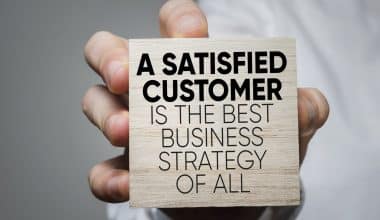The work environment is one of the most important aspects of any business. It affects the productivity, morale, and overall success of the company. It is important to understand the meaning of a work environment, its types, and how to improve it. And that’s what this article will talk about.
What do you mean by work environment?
Work environment refers to the physical, psychological, and social conditions in the workplace. It includes the physical layout of the office, the safety and security of the workers, the interpersonal relationships between coworkers, and the overall culture of the company. The work environment is also determined by the policies and procedures of the organization, as well as the attitudes and values of the employees. A positive work environment can motivate employees and help them be productive, while a negative one can lead to low morale, low productivity, and high turnover.
The work environment affects the performance of the organization as well as the well-being of the employees. A good environment is essential for the success of any company. It creates an atmosphere of trust, respect, and collaboration among the employees, which in turn leads to higher productivity and higher job satisfaction.
Types of Work Environment
There are two main types of work environments: toxic and good work environment.
A toxic work environment is characterized by low morale, high-stress levels, and bad interpersonal relationships between coworkers. This kind of environment can make people not care about their jobs and not work hard, which can lead to low job satisfaction and bad performance.
A good work environment, on the other hand, is characterized by high morale, low-stress levels, and positive interpersonal relationships between coworkers. This kind of environment can make people feel like they belong and have a purpose, which can make them happier at work and help them do a better job.
Toxic Work Environment
A toxic work environment is characterized by a lack of trust, respect, and collaboration between employees. This type of environment can lead to negative feelings such as fear, anxiety, and stress. Employees may feel like their opinions are not valued or respected, leading to low morale and low job satisfaction.
A toxic work environment can also lead to higher turnover rates due to employees leaving the company. This can be costly for the organization, as it leads to increased costs and time spent training new employees.
Some signs of a toxic work environment include:
- Employees feel like their opinions are not valued
- Poor communication between employees and management
- Unclear job expectations
- Discrimination and harassment
- High-stress levels
- Unreasonable workloads
Good Work Environment
A good work environment is characterized by trust, respect, and collaboration between employees. This type of environment can create a sense of belonging and purpose among the employees, leading to higher job satisfaction and improved performance.
A good work environment can also lead to higher employee retention rates due to employees feeling valued and wanting to stay with the company. This can be beneficial for the organization, as it leads to increased productivity and decreased costs associated with training new employees.
Some signs of a good work environment include:
- Employees feel valued and respected
- Clear job expectations
- Open and honest communication between employees and management
- Supportive and collaborative culture
- Low-stress levels
- Reasonable workloads
What is an example of a work environment?
An example of a good work environment is a company that values its employees and provides them with the resources they need to be successful. This type of company provides a safe and secure work atmosphere, where employees feel valued and respected by their peers and management.
The company also provides clear job expectations, open and honest communication, and a supportive and collaborative culture. This type of environment can create a sense of belonging and purpose, leading to higher job satisfaction and improved performance.
What are the five main qualities of the work environment?
The five main qualities of the work environment are trust, respect, collaboration, inclusion, and appreciation. Trust is important for employees to feel safe and secure in the workplace. Respect for each other’s opinions and ideas is essential for creating a positive environment. Collaboration between employees and management is important for creating a culture of teamwork and productivity. The inclusion of all employees is important for ensuring that everyone is valued and respected. Finally, appreciation for employees’ work and effort is essential for creating a positive work environment.
How to Improve Work Environment in the Office
Improving the work environment in the office is important for the success of any organization. Here are some tips on how to improve the work environment in the office:
- Encourage open and honest communication between employees and management.
- Create a culture of inclusion and respect for all employees.
- Make sure that employees’ opinions and ideas are valued and respected.
- Provide clear job expectations and reasonable workloads.
- Encourage collaboration and teamwork among employees.
- Provide employees with the resources and support they need to be successful.
- Recognize and reward employees for their hard work and efforts.
- Ensure a safe and secure work atmosphere.
By implementing these tips, you can create a positive work atmosphere that will lead to higher job satisfaction and improved performance.
How do you maintain a good work environment?
A positive work environment can promote collaboration and boost output. A bad work atmosphere can breed discontent, hinder productivity, and give staff you want to keep a cause to consider leaving. Here are some pointers from our executive coaching professionals on how to establish and preserve a good work atmosphere:
Indicate clearly who performs what.
Some workers will accomplish more than others. If their efforts are recognized and valued, they are more likely to be delighted to go above and beyond what is required of them and assist those workers who might be falling behind. Making no differentiation between different degrees of effort, however, may lead those who put in more effort to question the point of doing so.
experts in executive coaching state You may show that you are treating everyone equitably by explicitly outlining roles and duties in advance and not just assuming that the harder workers would accomplish more.
If multiple employees compete for control of a given work, clearly delineating roles and responsibilities can prevent turf wars. On the other hand, it might also guarantee that someone will be in charge of work that no one wants to do.
Avoid micromanaging.
Take a step back after assigning jobs and duties. Give your workers the freedom to complete their tasks without nagging at them all the time. Trusting your staff to complete their work effectively and efficiently will empower them. It may be necessary to check in on them sometimes, but avoid scheduling too many staff meetings and progress reports that interfere with getting the job done.
Maintain open channels of communication
You might not be aware of issues that occasionally develop at work. There might not be enough supplies. A personality conflict between two coworkers may exist. You might be able to deal with problems while they are minor and easier to handle rather than letting them fester and start to hinder productivity if your employees know they can feel free to come to you with their concerns.
Let your staff know they are appreciated.
Praise is always appreciated and certainly helps to create a positive work environment when things are going well. The absence of praise makes it harder to create a positive workplace culture. Executive coach experts advise against taking people for granted, even if extra effort is necessary. Allowing someone to arrive late or depart early after working late the day before is a little but effective show of appreciation.
What three words best describe your work environment?
The three words that best describe my work environment are respect, support, and collaboration. My colleagues and I respect each other’s opinions and ideas, and we are always willing to help each other out. We also try to make a culture that is supportive and encourages open communication and working together.
What are the four basic work types?
The Thinker, Builder, Improver, and Producer job types are the four basic building blocks or work types that make up all jobs.
The first type of work, the thinker, generates brilliant ideas. The second category of workers transforms these concepts into reality. The third type of improver makes this reality better. The fourth type of job is a producer, who performs the same task repeatedly while providing clients with repeatable, high-quality goods and services.
What are the six work environments?
Together, people with similar personality types can build a workplace that is conducive to their style. For instance, when artistic people work together, they create an environment that encourages and rewards artistic behavior and thought.
There are six fundamental categories of workplaces:
Realistic, Investigative, artistic, social, businesslike, and conventional. “Work” covers anything that is done for a specific goal, such as paid and unpaid work, volunteering, sports, or hobbies. Individuals look for settings where they may make use of their talents and express their morals and attitudes. As an illustration, investigative personalities go for investigative environments, artistic personalities seek artistic environments, and so on. Individuals are more likely to be successful and content if they chose a workplace that fits their personality type.
For instance, if they decide to work in an atmosphere that values creativity and expression, such as teaching dance in a dancing school, artistic people are more likely to be successful and content in their careers.
Conclusion
Your work environment needs to be a good fit for your personality type if you want to be content and successful in your profession. Professional settings should encourage a positive culture with good communication, enough resources, and opportunities to move up in your career. Also, they ought to fit your personality, ideals, and working style. I do hope this article answered all the questions you had in mind.
- THE IDEAL WORK ENVIRONMENT: Things That Make up an Ideal Work Environment
- 4 Signs You Should Quit That Job and How
- RESPECT IN THE WORKPLACE: Best Ways to Demonstrate It & The Importance
- How to Compete with Online Retail as a Physical Business?
- BAD BOSS SIGNS: How to Identify and Deal with a Bad Boss





